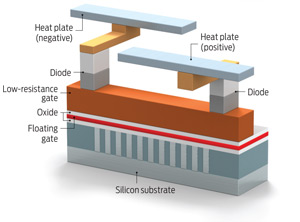Researchers at Taiwanese electronics firm Macronix have found a way to make NAND flash memory chips last much longer. Using short bursts of intense heat (800°C) it was found that damaged memory locations returned to working order. NAND memory could be “healed” this way to make it last to approximately 100 million program/erase cycles.
Phase change RAM (PCRAM) uses memory chips with heating elements and it was previously found that intense heat bursts could heal PCRAM modules. The researchers at Macronix thought they would try the same technique on flash memory and it has proved to be of great utility. They have redesigned the chips so that gate electrodes can carry heat to the memory cells. The chips can then be zapped with intense heat pulses to improve their endurance.

Illustration by Emily Cooper
Current NAND flash memory is said to have a lifespan of only 10,000 cycles so 100 million is a great enhancement to its durability. NAND flash relies upon an oxide layer though which current flows to flip a bit value. This oxide layer degrades over time and eventually fails. The heating process anneals the oxide layer and massively prevents any degradation. Macronix have known about the benefits of heating for a long time but previously used to bake NAND chips in an oven at around 250C for a few hours to anneal them – that’s an expensive and inconvenient thing to do for electronic components!

An interesting side effect of the in chip heating is that faster erasing was possible while the chips were hot. “Further down, this may evolve into a ‘thermally assisted’ mode of operation that gives both better performance - such as the faster erasing - and better endurance flash memory” said project deputy director Hang‑Ting Lue of Macronix.
The 800 degree zapping on memory cells only needs to be done infrequently to practically prevent degradation. As with many new innovative processes it may be a while before this technology becomes available commercially.













